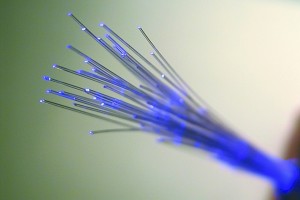A new ultra-high-speed broadband network capable of moving large amounts of data at rates up to 100 gigabits per second will soon allow researchers at UConn Health and UConn’s main campus in Storrs to collaborate more effectively with each other and their peers around the globe.
The network, expected to be operational by the end of the year, is 100 times faster than the 1 gigabit per second bandwidth capability currently working on the fastest platforms available to students and faculty at UConn’s main campus in Storrs.
How fast is 100 gigabits per second? Consider this: a two-hour high-definition movie that would take an hour to download at 10 megabits per second speed could be completely downloaded in about 30 seconds at the 100 gigabit rate.
The faster service is possible because the University is upgrading its broadband capacity to take advantage of faster connectivity provided by the global Internet2 Network backbone. The Internet2 Network is a lightning-fast alternate broadband superhighway created and managed by some of the nation’s leading higher education institutions, industries, and research organizations for science purposes.
Similar high-speed networks have been developed by the National Science Foundation, U.S. Department of Defense, U.S. Department of Energy, and other organizations to connect vital laboratories and supercomputers around the country with vast amounts of information stored around the world like that generated by the Large Hadron Collider.
The robust CEN-Internet2 network expands the boundaries of science that researchers can explore [and] forms the foundation for enhanced collaboration among research institutions. — Jeffrey Seemann, vice president for research
Improvements to the University’s broadband infrastructure are being led by University Information Technology Services (UITS) and the Connecticut Education Network (CEN), which is the regional broadband network provider UConn uses to link to Internet2.
According to Michael Mundrane, vice provost for information technology and the University’s chief information officer, leveraging the evolving capabilities of the Internet2 network will allow UConn researchers to interact with colleagues, systems, and services, regardless of their location, “as if they are right next door.”
Jeffrey Seemann, UConn’s vice president for research, says, “The robust CEN-Internet2 network expands the boundaries of science that researchers can explore. It forms the foundation for enhanced collaboration among research institutions – particularly UConn and UConn Health – and these improvements to the network enable the scientific breakthroughs that are of strategic importance to the economy of Connecticut.”
The network improvements will significantly enhance the research capabilities of researchers such as Professor Rachel O’Neill, director of UConn’s Center for Genome Innovation at the Institute for Systems Genomics in Storrs. Her lab conducts next generation sequencing for single cell genomic analysis, and routinely works with terabytes of data.
When a serial drive with 58 terabytes of sequencing data recently crashed in O’Neill’s lab, it took researchers nearly a week to reload the data on a 1 gigabit line. Having access to a 100Gbps line would reduce that time significantly. More importantly, O’Neill says, the faster broadband will allow her to collaborate with other researchers more easily and efficiently on important projects.
“When you have scientists working on genome sequencing from all ends of the state – and of the globe – these speeds are the difference between making innovative leaps and just taking a jog behind the leading pack,” says O’Neill.
That faster broadband includes a 40 gigabit line stretching between Storrs and UConn Health that will be dedicated exclusively for science research. The line, which will operate with other cyberprotections instead of a traditional firewall to improve speed, is expected to be used by a variety of disciplines. For instance:
- The geography department will be able to continuously access high-resolution satellite images stored on external servers.
- The physics department will be able to participate in the Open Science Grid, a global community of scientists and researchers that share vast amounts of information via high-throughput computing in order to solve scientific problems.
- The statistics department will be able to conduct advanced statistical modeling research using large data sets produced by health and biomedical studies.
While the initial Storrs campus upgrades are expected to go online later this year, labs at UConn Health in Farmington, like the Richard D. Berlin Center for Cell Analysis and Modeling (CCAM), already have access to the 100Gbps lines.
“There are not many institutions in the country that have access to this kind of Internet,” says Ion Moraru, director of the CCAM’s high-performance computing facility. “This puts us on the same tier as national labs like Oak Ridge and Lawrence Livermore and universities like Indiana and UC San Diego that have a long tradition of supercomputing.”
Moraru and associate professor of computer science and engineering Bing Wang received grants from the National Science Foundation last year to support the University’s plans for expanding its broadband capacity.
“The main goal of this project is to provide at least 10 times improvement in network speed to UConn and UConn Health … to enable data-intensive scientific research,” Wang says.
Khamis Abu-Hasaballah, UConn’s assistant vice president for research and research IT services and director of the University’s Research Informatics Core, says the faster connectivity is necessary to support UConn’s expanding research interests.
“Modern research and the deluge of big data is going to make it necessary for any institution conducting significant research in areas like genomics and bioinformatics to have high-speed service like Internet2,” Abu-Hasaballah says.
O’Neill agrees.
“Big data, whether it’s sequencing data, imaging data, or digital visualization, is here to stay,” says O’Neill. “Even if sequencing data files are reduced in size, there will still be an increase in their sheer number due to reduced cost and accessibility. Couple that with personalized medicine initiatives and you have a need for fast data transfer between labs, universities, hospitals, and soon, patient care sites.”




